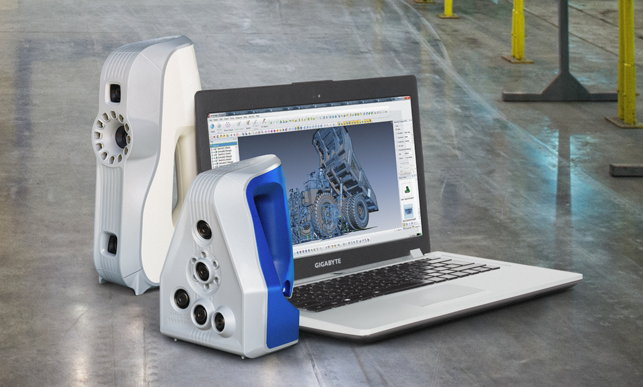
Artec’s Eva (left) and the SpaceSpider (right)
3D scanners have always been curious beasts and it seems as if they’re only getting more curious in terms of the interest they’re generating.
A couple of years ago, you’d have been looking at upwards of £20,000 for a professional-level system that allowed you to accurately capture the physical form of an object.
Today, while there’s still a lot of action at the high end of the spectrum, there are also plenty of entry-level models available at a fraction of the price.
While many of these lower-end devices come with very specific limitations and tend to capture detail at a resolution that’s unsuitable for more complex tasks (such as reconstructing geometry, for example), their arrival has at least had the effect of lowering costs across the board.
Artec is a vendor that’s been shouldering some of the hard work in terms of bringing down costs. Based in Luxembourg, its products have been adopted across a wide range of industries, from heritage and the arts to product design and manufacturing.
At DEVELOP3D, we recently spent some time working with Artec’s entry-level Eva scanner and its all-singing, all-dancing SpaceSpider, in order to get a better idea of the role they can play in product design.
To dig deeper, we also met up with one of Artec’s leading UK partners, Patrick Thorn and Associates.
Set-up process
Both the Eva and the SpaceSpider share the same software and the same set-up process.
Getting the hardware up and running is simply a case of connecting up the power cable and USB connection.
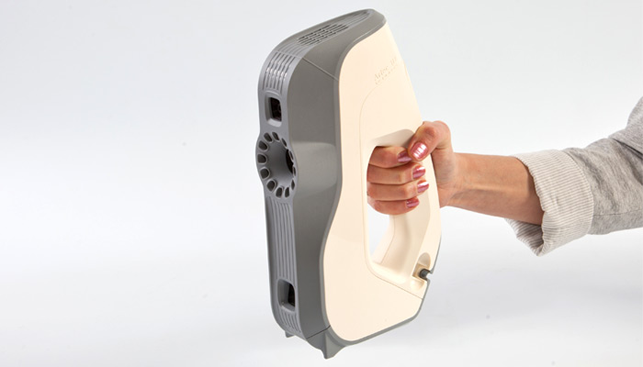
The Artec Eva – about the size of a standard kitchen kettle
(These scanners are supplied with cables long enough to make them manoeuvrable, even while tethered to your workstation.)
On the software front, there are two key stages. The first you’ll need to tackle is the installation process. This is how the scanners are activated and registered to your account.
Once that process is complete, you’ll move on to using the Artec Studio application. This is pretty standard in terms of how it looks and works and the starting point is to kick off a scan. This part of the process is worth breaking down.
There are a couple of approaches to scanning and the selection of the most appropriate method depends on your scanner and the object you’re looking to scan.
In most cases with these devices, you’ll be able to scan an object without the use of registration targets. Because they are white light-based, they’re pretty good at tracking an object and allowing you to scan a large proportion of it in one go.
That said, you’re always going to need to conduct several scans and then register them together. Line of sight is key here.
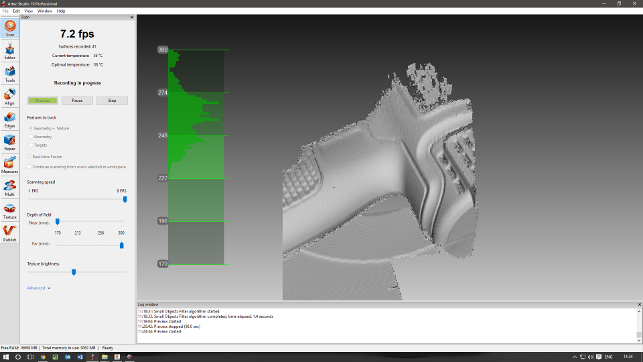
Artec’s software is what really makes the device sing. Here, you can see the scan in progress, with a distance gauge to help judge the process
To get started, you simply fire up the software and hit the button on the device.
This kicks off the preview in the software, so that you can instantly get a feel for the distance you need to maintain between the scanner and the object. Hit the same button again and you’re off.
It takes a little practice to get the hang of using these things, but with a little time,you’ll be scanning your object like a pro.
As you scan, the software is streaming in the points from the device and displaying them on your screen. There’s also a prominent distance gauge in the model window, so you can see how you’re doing.
As you move around the object, the scanner uses geometry tracking to keep everything together, but if you stray away too quickly, it’ll lose that tracking and the workstation will beep. Hit the button again, then start another scan or, if you’re ready, dive into the post-processing.
Here, you use the software’s alignment tools, both manual and automated, to align your scans (typically using common points between separate scan sets) and to do the clean-up and post-processing work.
The Artec Studio application has a very rich set of tools for this (meaning you don’t need to invest in additional software), from simple clean-up and removal of ‘noise’, to alignment and on into hole filling, edge refinement and much more.
Artec – Real-time fusion
While separate scans and registration/alignment are pretty common practice, the Artec Studio software has another trick up its sleeve in the form of its realtime fusion capability.
This uses the power of your graphics card (you’ll need a pro-level card that supports OpenCL 1.1) to enable you to scan whole objects and have the system capture all of the geometry in a single stream, saving you the hassle of aligning separate scans.
That said, there is always a trade-off to working at speed: in this case, the geometry will lose a bit of accuracy. Artec doesn’t recommend using this method if your goal is metrology and serious measurement, but if you want to grab a very quick scan, then it’s ideal.
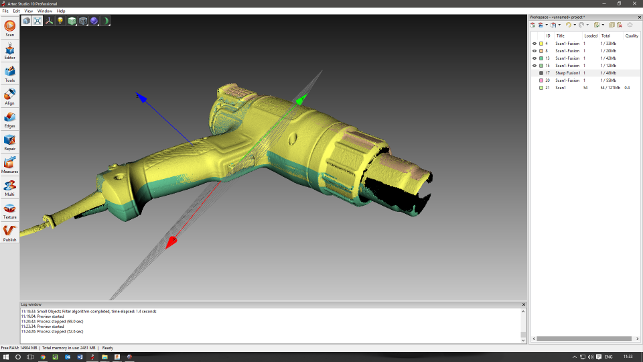
Artec Studio includes a rich set of tools to help align separate scans and repair your data
Artec – Eva versus SpaceSpider
The technical differences between these two devices are pretty clearly defined by the resolution to which they scan and the working distances that they offer.
The entry-level Eva captures data around the 0.5mm resolution mark (with 0.1mm accuracy) and can work at a distance of between 400mm and 1,000mm from the object being scanned.
The SpaceSpider, on the other hand, works to 0.1mm (with 0.05mm accuracy) and can operate at distances between 170mm and 350mm from the object.
From that data, it’s clear that the Eva is aimed at those looking to scan less complex, but perhaps larger objects, while the SpaceSpider, with its greater accuracy and resolution, is aimed at scanning smaller objects and certainly, those requiring much more detailed capture.
There’s also a distinct pricing difference between the two and there are some good reasons for that. For a start, the SpaceSpider contains twice as many cameras, to enable higher-resolution scans, but it also achieves a good running temperature much faster.
This is something that may not be immediately obvious, but the tolerances in these devices mean that optimum temperature is what gives you more consistency and reliability.
The SpaceSpider is ready to go in three minutes, whereas the Eva is ready to go immediately.
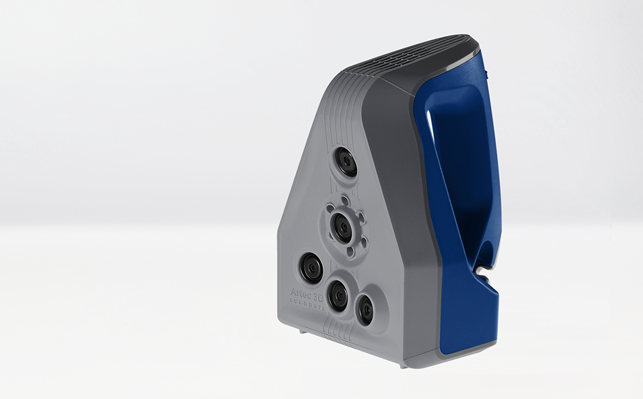
The more diminutive Space Spider packs in more scan detail and texture
The Eva, as we’ve discussed, is Artec’s entry-level product and it’s priced at €13,700, with an additional €1,000 for the Artec Professional Studio software.
There is an even cheaper option, the Eva Lite, but it doesn’t capture textures. This is priced at €9,700.
The SpaceSpider, by contrast, costs €20,700 – a considerable hike, but this is the cream of the crop, intended for ultra-accurate jobs, such as might be found in the medical and metrology fields.
The devices are comfortable to use (both weighing under 1kg) and the set-up process is as straightforward as it gets.
What really makes these devices stand out, however, is the Artec Studio software.
This is what enables you to do all of your scanning work, work through alignment and registration and then clean up and export data — all via a single interface and a single product, with no need to purchase additional tools.
Scanning is a tricky business, beset by all kinds of challenges. You need to familiarise yourself with the idiosyncrasies of a specific device and its software, and carefully prepare both your object and its environment for capture.
A day’s training with Pat Thorn helped me get up to speed far more quickly than I would have done on my own.
There’s a lot of action in the 3D scanning world these days, particularly at the lower end of the spectrum. A scanner like Artec’s Eva is perfect for non-critical jobs, where you need to grab a quick scan, typically of something organic in shape.
But when it comes to capturing complex engineering forms, you need more than that. Here, Artec’s SpaceSpider is perhaps the best fit. The resolution and accuracy of the data it captures, along with tools to prepare that data for reuse in design, makes it a very compelling solution.
It’s a relatively costly one, but it’s one that works efficiently and gets the job done in the quickest time possible.
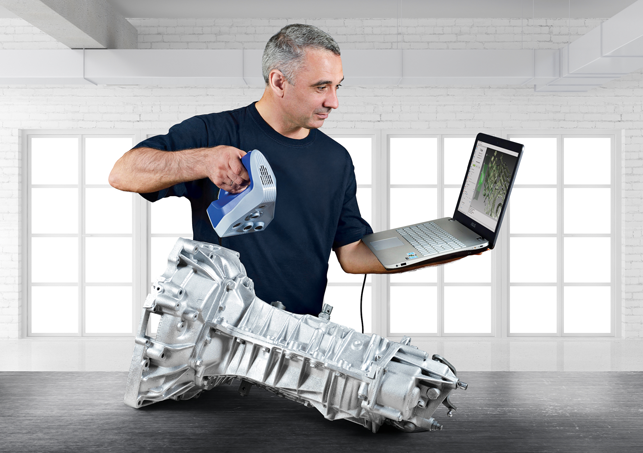
The Artec Space Spider – high resolution capture for reverse engineering in design and inspection
Tech specs
Artec Eva
» Scan speed: 16 frames per second
» 3D resolution: 0.5mm
» 3D point accuracy: 0.1mm
» Texture resolution: 1.3 megapixels
» Working distance: 0.4m – 1m
» Closest field of view: 214mm × 148mm
» Furthest field of view: 536mm × 371mm
» 0.85 kg
» Price €13,700
Artec SpaceSpider
» Scan speed: 7.5 frames per second
» 3D resolution: 0.1mm
» 3D point accuracy: 0.05mm
» Texture resolution: 1.3 megapixels
» Working distance: 0.17m – 0.35m
» Closest field of view: 90mm × 70mm
» Furthest field of view: 180mm × 140mm
» 0.85 kg
» Price €20,700







Pingback: Jämförelse mellan Artec 3D-skannrar – Creative Tools blogg